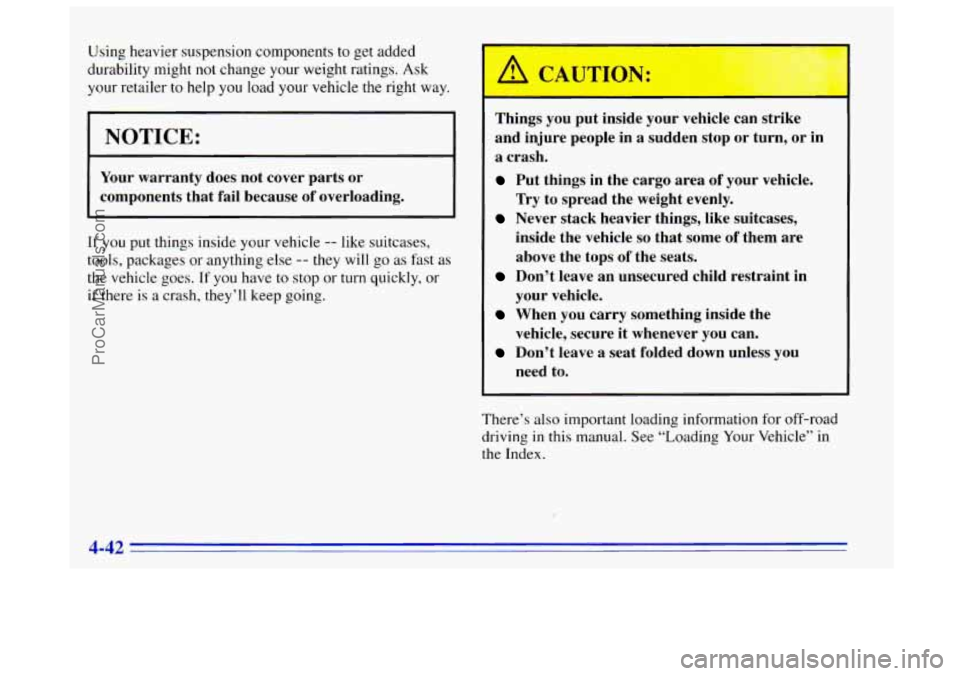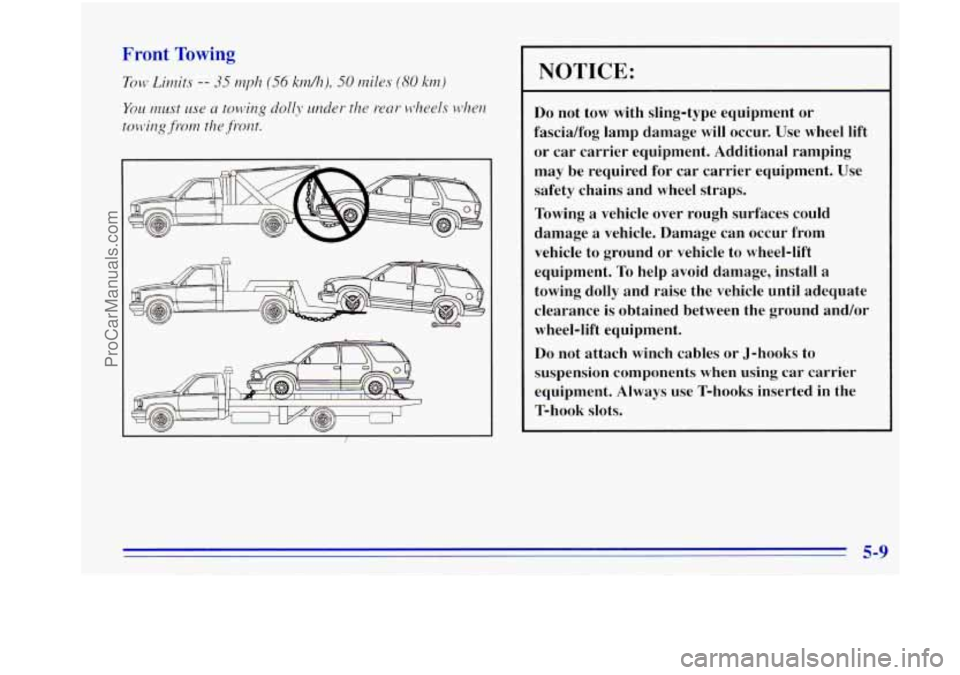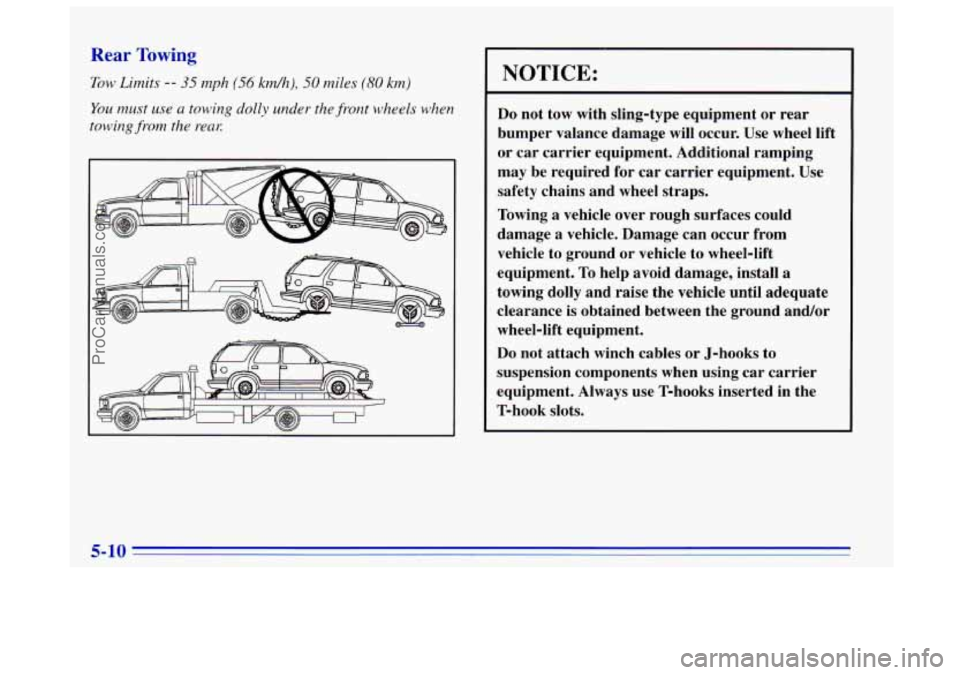suspension OLDSMOBILE BRAVADA 1996 Owners Manual
[x] Cancel search | Manufacturer: OLDSMOBILE, Model Year: 1996, Model line: BRAVADA, Model: OLDSMOBILE BRAVADA 1996Pages: 340, PDF Size: 17.49 MB
Page 155 of 340

After Off-Road Driving
Remove any brush or debris that has collected on the
underbody, chassis or under the hood. These
accumulations can be a fire hazard.
Driving at Night
After operation in mud or sand, have the brake linings
cleaned and checked. These substances can cause
glazing and uneven braking. Check the body structure,
steering, suspension, wheels, tires and exhaust system
for damage. Also, check the fuel lines and cooling
system for any leakage.
Your vehicle will require more frequent service due to
off-road use. Refer to the Maintenance Schedule for
additional information.
Night driving is more dangerous than day driving. One reason is that some drivers are
likely to be impaired -- by
alcohol or drugs, with night vision problems, or by fdtigue.
ProCarManuals.com
Page 170 of 340

Using heavier suspension components to get added
durability might not change your weight ratings. Ask
your retailer to help you load your vehicle the right way.
NOTICE:
I
I
Your warranty does not cover parts or
components that
fail because of overloading.
If you put things inside your vehicle
-- like suitcases,
tools, packages
or anything else -- they will go as fast as
the vehicle goes. If you have to stop or
turn quickly, or
if there is a crash, they’ll keep going. Things
you put inside your vehicle can strike
and injure people in a sudden stop or turn, or in
a crash.
Put things in the cargo area of your vehicle.
Never stack heavier things, like suitcases, Try to spread the weight evenly.
inside the vehicle
so that some of them are
above the tops of the seats.
Don’t leave an unsecured child restraint in
your vehicle.
When you carry something inside the
vehicle, secure it whenever
you can.
Don’t leave a seat folded down unless you
need to.
There’s also important loading information
for off-road
driving in this manual. See “Loading Your Vehicle” in
the Index.
ProCarManuals.com
Page 187 of 340

1 A CAUTION:
I
~ To help avoid injury to you or others:
0 Never let passengers ride in a vehicle that is
Never tow faster than safe or posted speeds.
Never tow with damaged parts not fully
Never get under your vehicle after it has
Always use separate safety chains on each
Never use J-hooks. Use T-hooks instead.
being
towed.
secured.
been lifted by the tow truck. side when towing a vehicle. I
A CAUTION:
A vehicle can fall from a car carrier if it isn’t
adequately secured. This can cause a collision,
serious personal injury and vehicle damage. The
vehicle should be tightly secured with chains or
steel cables before it
is transported.
Don’t use substitutes (ropes, leather straps,
canvas webbing, etc.) that can be cut by sharp
edges underneath the towed vehicle. Always use
T-hooks inserted in the T-hook slots. Never use
J-hooks. They
will damage drivetrain and
suspension components.
When your vehicle is being towed, have the ignition key
turned to the
OFF position. The steering wheel should
be clamped
in a straight-ahead position with a clamping
device designed for towing service.
Do not use the
vehicle’s steering column lock for this. The transmission
should be
in NEUTRAL (N). The parking brake should
be released.
5-7
ProCarManuals.com
Page 189 of 340

i
NOTICE:
Do not tow with sling-type equipment or
fascia/fog lamp damage will occur. Use wheel lift
or car carrier equipment. Additional ramping
may be required for car carrier equipment. Use
safety chains and wheel straps.
Towing
a vehicle over rough surfaces could
damage a vehicle. Damage can occur from
vehicle to ground or vehicle to wheel-lift
equipment.
To help avoid damage, install a
towing dolly and raise the vehicle until adequate
clearance
is obtained between the ground and/or
wheel-lift equipment.
Do not attach winch cables or J-hooks to
suspension components when using car carrier
equipment. Always use T-hooks inserted in the
T-hook slots.
ProCarManuals.com
Page 190 of 340

Rear Towing
Tow Limits -- 35 mph (56 kmh), 50 miles (80 km)
You must use a towing dolly under the front wheels when
towing from the rear.
NOTICE:
Do not tow with sling-type equipment or rear
bumper valance damage will occur. Use wheel lift
or car carrier equipment. Additional ramping
may be required for car carrier equipment. Use
safety chains and wheel straps.
Towing a vehicle over rough surfaces coula
damage a vehicle. Damage can occur from
vehicle
to ground or vehicle to wheel-lift
equipment. To help avoid damage, install
a
towing dolly and raise the vehicle until adequate
clearance is obtained between the ground and/or
wheel-lift equipment.
Do not attach winch cables or J-hooks to
suspension components when using car carrier
equipment. Always use T-hooks inserted in the
T-hook slots.
ProCarManuals.com
Page 276 of 340

I Short Trip/City Maintenance Schedule
The services shown in this schedule up to 100,000 miles
( 166 000 km) should be performed after 100,000 miles
(166
000 km) at the same intervals.
Footnotes
? The U.S. Environmental Protection Agency or the
California Air Resources Board has determined that the
failure to perform this maintenance item will not nullify
the emission warranty or limit recall liability prior to the
completion of the vehicle’s useful life. We, however,
urge that all recommended maintenance services be
performed at the indicated intervals and the maintenance
be recorded.
# Lubricate the front suspension, ball joints, steering
linkage, parking brake cable guides, propshaft splines,
universal joints and brake pedal springs.
**Drive axle service:
Drain and refill at first oil change. At subsequent oil
changes, check fluid level and add fluid as needed.
If
driving in dusty areas or towing a trailer, drain fluid
and refill every
15,000 miles (25 000 km).
More frequent lubrication may be required for
off-paved-road use.
ProCarManuals.com
Page 298 of 340

I Long Tripmighway Maintenance Schedule 1
The services shown in this schedule up to 100,000 miles
(I 66 000 kin) should be performed after 100,000 miles
(166 000 km) at the same intervals.
Footnotes
The U.S. Environmental Protection Agency or the
California Air Resources Board has determined that the
failure to perform this maintenance item will not
nullify
the emission warranty or limit recall liability prior to the
completion of the vehicle’s useful life. We, however,
urge that all recommended maintenance services be
performed at
the indicated intervals and the maintenance
be recorded.
# Lubl-icat.e t.he front suspension, ball joints, steering
linkage, parking brake cable guides, propshaft splines,
universal joints and brake pedal springs.
-I-+Drive axle service:
0 Drain and refill at first oil change. At subsequent oil
changes, check fluid level and add fluid as needed. If
driving in dusty areas or towing a trailer, drain fluid
and refill every
15,000 miles (25 000 km).
0 More frequent lubrication may be required for
off-paved-road use.
. . .1.
ProCarManuals.com
Page 313 of 340

Part C: Periodic Maintenance
Inspections
Listed below are inspections and services which should
be performed at least twice
a year (for instance, each
spring and fall).
You should let your GM retailer’s
service department or other qualified service center do
these jobs. Make sure any necessary repairs are
completed at
once.
Proper procedures to perform these services may be
found in an Oldsmobile Service Manual. See “Service
and Owner Publications’’ in the Index.
Steering, Suspension and Front- Wheel-Drive
Ax . Boot and Seal Inspection
Inspect the front and rear suspension and steering
system for damaged,
loose or missing parts, signs of
wear or lack
of lubrication. Inspect the power steering
lines and hoses for proper hook-up, binding, leaks,
cracks, chafing, etc. Clean and then inspect the drive
axle boot seals for damage, tears or leakage. Replace
seals if necessary.
Exhaust System Inspection
Inspect the complete exhaust system. Inspect the body
near the exhaust system.
Look for broken, damaged,
missing or out-of-position parts as well as open seams,
holes, loose connections or other conditions which
could cause a
heat build-up in the floor pan or could let
exhaust fumes into the vehicle. See “Engine Exhaust”
in
the Index.
Radiator and Heater Hose Inspection
Inspect the hoses and have them replaced if they are
cracked, swollen or deteriorated. Inspect all pipes,
fittings and clamps; replace as needed.
Throttle Linkage Inspection
Inspect the throttle linkage for interference or binding,
and for damage or missing parts. Replace parts as
needed. Replace any cables that have high effort or
excessive wear.
Do not lubricate accelerator and cruise
control cables.
7-43
ProCarManuals.com
Page 333 of 340

Halogen Bulbs ................................ 6-30
Hazard Warning Flashers
.......................... 5-1
Head Restraints
................................. 1-3
Headlamps
.................................... 2-31
Bulb Replacement
............................ 6-3 1
High/Low Beam Changer ...................... 2-25
OnReminder
................................ 2-31
Wiring
..................................... 6-53
Hearing Impaired. Customer Assistance
.............. 8-3
Heating
........................................ 3-3
Highway Hypnosis
.............................. 4-35
Hill and Mountain Roads
......................... 4-35
Hitches. Trailer
................................. 4-46
Hood
.......................................... 6-6
Horn
......................................... 2-23
Hydroplaning
.................................. 4-3 1
Ignition Positions .............................. 2- IO
Inflation. Tire ............................. 6.38. 7.39
Inside Daymight Rearview Mirror
................. 2-33
Inspections Brakesystem
................................ 7-44
Drive Axle
.................................. 7-44
Exhaust Systems
............................. 7-43
Radiator and Heater Hose
...................... 7-43
Steering
.................................... 7-43
Suspension
.................................. 7-43
Throttle Linkage
.............................. 7-43
Transfer Case
................................ 7-44 Instrument
Panel
............................... 2-46
Cleaning
.................................... 6-46
Cluster
..................................... 2-48
FuseBlock
.................................. 6-53
Interior Lamps
................................. 2-32
Jacking Equipment
............................. 5-21
Jump Starting
................................... 5-2
Keyless Entry System
........................... 2-5
Keys
.......................................... 2-1
Labels
Certificationflire
.............................. 4-41
Fuse
....................................... 6-54
Safety Belt
.................................. 1-43
Service Parts Identification
..................... 6-52
Vehicle Identification Number
................... 6-52
Lamps
........................................ 2-30
Dome
...................................... 2-33
Front Reading
........................... 2-32. 2-35
Interior
..................................... 2-32
OnReminder
................................ 2-31
Leaving Your Vehicle
............................. 2-4
Leaving Your Vehicle
with the Engine Running ....... 2-19
Lighter
....................................... 2-41
ProCarManuals.com